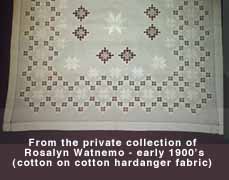In the early 1900's linen was becoming scarce and an alternative
fabric was needed. Cotton had become more readily available and
soon supplanted the use of linen. Cotton sultan grew in popularity
and came to be specifically known as Hardanger fabric. Colors
were also introduced, resulting in a contemporary adaptation
of this venerable old textile art. More recently, Hardanger canvas
manufactured especially for this purpose came to be used, but
some sizes of scrim and congress canvas and many dress materials
were also adapted to suit the work. Since linen was scarce, it
was often used to make only the accents on a garment, such as
collars, front tabs and cuffs on a blouse or shirt or as an insert
for an apron. Household linens were stitched almost exclusively
on cotton sultan.
A new trend took hold in the early part of the twentieth century,
of adding surface embroidery to Hardanger work. The two principal
stitches used were satin or kloster stitch for the solid portions
of the design and over and under woven bars for the drawn spaces.
Satin stitch variations, eyelets, back stitch, fagot and reverse
fagot, four sided stitch and kloster block variations embellished
with luxurious lace filling stitches were integrated with them.
Open areas were also embellished with double and diagonal bars,
dove's eye and spider web stitches. Picots could be added to
woven bars while weaving. Norwegian picots were tight little
knots. Today picots are more often small lacy loops.
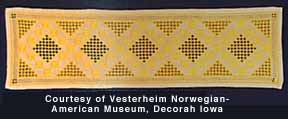
The mid 1800's to the early 1900's saw a huge tide of immigration
from the Scandinavian countries to the U.S. and with them came
their native embroidery skills and techniques. Before this mass
transplantation Hardanger was a relatively obscure and isolated
embroidery technique. The "Ladies Home Journal", May,
1901 issue, published the first introduction to Hardanger in
America, written by the editor of The Lace Maker, Sara
Hadley. This article and several subsequent others on the subject
were later consolidated and published as The Complete Hardanger
Book in 1904 and as Supplementary Lessons in Hardanger in 1906, both put out by D.S. Bennett. There followed more books
by T. Buettner and Co., Butterick, DMC, Belding and Priscilla.
For those who wish to investigate a period publication on Hardanger,
Dover Books currently stocks Hardanger Embroidery by Sigrid
Bright which is a reprint of the Clark ONT J. Coats Priscilla
book of 1909. Part of this book was also reprinted by Tower Press
in 1981 as the Hardanger Book.
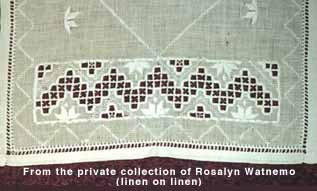
During and after the period of the two World Wars, much of this
embroidery diminished in use and faded from sight. The publication
of Jean Kimmond's Embroidery for the Home and a J.P. Coats
publication helped generate a resurgence of interest in Hardanger.
Since the 1970's, this spark has grown by leaps and bounds due
to the publication of numerous books and leaflets and through
the efforts and work of Marion Scoular, Rita Tubbs, Evelyn MacKay,
Janice Love, Elvia Quinn, Gayle Hillert and Alphea Iverson. This
revival has spurred classes and correspondence courses, the publication
of a newsletter and even an annual contest for Hardanger enthusiasts,
sponsored by Nordic Needle of Fargo, ND.
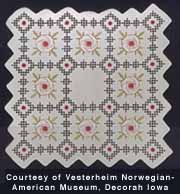
Another superb resource for this art form is Vesterheim (Western
Home) Norwegian-American Museum, which is tucked away in the
small town of Decorah in northeast Iowa. This Norwegian- American
institution is one of the outstanding ethnic museums of America,
specializing in the preservation of Norwegian-American art, crafts,
artifacts, tools and architecture, telling the story of Norwegian
immigrants, encompassing their home and life in Norway, their
journey to America and their adaptation to a new home in the
Midwestern part of this country. In the U.S., the women from
Norway created some of the loveliest Hardanger embroideries in
the world. The textile area of the museum exhibits a bunad (festive
folk costume) for almost every part of Norway, as well as examples
of weaving, tatting, blackwork, crocheting, knitting, rosesaum
(rosework), and hvitsom (whitework, of which Hardanger embroidery
is a part). The bunads from different parts of Norway can vary
greatly in style. The typical Hardanger, or west coast costume,
consists of an apron (often with an embroidered panel), long
sleeved blouse of white linen with embroidered collar and cuffs,
long black wool skirt and a red woolen sleeveless bodice. The
bunads of the Hardanger district are the only ones with this
now famous, embroidery technique. The examples of Hardangersom
at Vesterheim encompass a collection of works dating from the
late 1700's to the present as well as several trousseaus, spanning
from 1880 to the early 1920's.
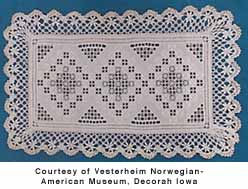
There is some controversy regarding some of the embroidery which
is given the appellation of Hardanger. What began as a decoration
for household linens has been turned into something else which
purists refer to as "American Hardanger." This would
include any work which employs colors other than white or cream
or is executed on cotton rather than linen cloth. Applications
for these contemporary "American Hardanger" embroideries
have grown to encompass tablecloths, doilies, runners, wallhangings,
pillows, bedspreads, baptismal and wedding gown trims, bookmarks,
Christmas ornaments, bellpulls, sun catchers, liturgical vestments,
needle cases, pincushions, coasters, bread covers and even doll
clothes. However, even though the designs, applications and materials
have multiplied since the 18th century, the basic techniques
remain the same. White-on-white remains the most traditional
and, for many, the most elegant choice for Hardanger embroidery.
Traditionalists can continue to work Hardanger in its original
pure form, while those who are more experimentally inclined can
employ the numerous new choices of materials now available.
Thanks to places like Vesterheim Norwegian American Museum, which
preserve the traditional embroidery examples and techniques which
the immigrants transplanted to the New World, and to talented
designers, who have combined original stitches and techniques
with new fabrics, threads, colors and embellishments, to add
a contemporary, vibrant flair to Hardanger embroidery, that compel
enthusiastic new stitchers to take up this art, Hardangersom
has enjoyed a renaissance and is once more a vital and popular
form of needleart.
For more information on Vesterheim Norwegian-American Museum located at 523 W. Water Street, P.O. Box 379, Decorah, Iowa,
52101-0379, please call them at (319) 382-9681 or visit their
website at http://www.vesterheim.org
Information for this story was gathered from many sources, most
notably The Hardangersom of Vesterheim Vol. II by Carolynn
Craig Gustafson, which is available from Nordic Needle. Special
thanks also to Vicki McEntaffer of Kunsten Needle Art, Roz Watnemo of Nordic Needle and Laurann Gilbertson,
curator of textiles at Vesterheim Norwegian-American Museum,
for generously sharing their time, knowledge and related materials
concerning the history of Hardanger embroidery.
For more information on Rosalyn Watnemo and Nordic
Needle see this month's Designer Spotlight and Shop Focus. Nordic Needle has some vintage Hardanger table
and bed linens for sale, which can be viewed on their website
at http://www.nordicneedle.com/antique.htm
For more information on Vicki McEntaffer, Kunsten Needle Art, Lillill Thuve or Thuve-Stua designs see last month's Innovation Gallery Feature.
For those interested in other Norwegian cultural events, please
see the Sons of Norway website at http://www.sofn-district6.com

